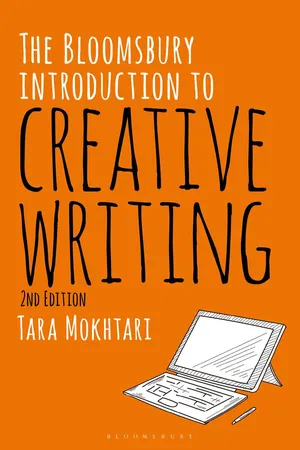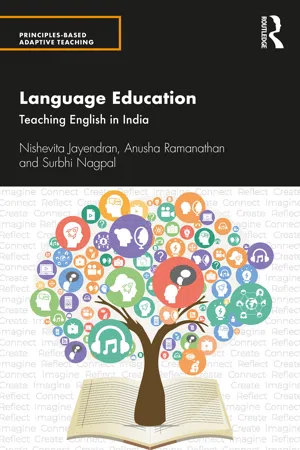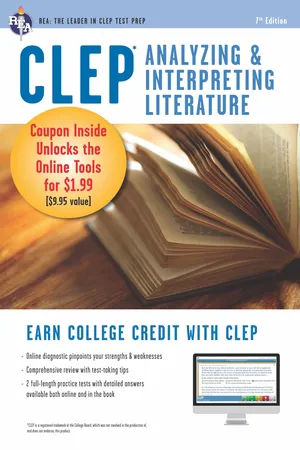Literature
Poetic Devices
Poetic devices are techniques used by poets to create a desired effect or convey a particular message in their work. These devices include rhyme, meter, alliteration, assonance, imagery, metaphor, simile, personification, and hyperbole, among others. They help to enhance the beauty and meaning of a poem.
Written by Perlego with AI-assistance
Related key terms
3 Key excerpts on "Poetic Devices"
- eBook - ePub
- Tara Mokhtari(Author)
- 2019(Publication Date)
- Bloomsbury Academic(Publisher)
Whether you have been writing poetry daily in a journal since puberty hit (oh dear) or whether the mere mention of the word “poetry” onsets symptoms of post-traumatic stress with flashbacks to Shakespeare classes in high school (also, oh dear), it’s important to eventually acknowledge that poetic techniques are essential to all of your literary endeavors in one way or another. To comprehend the functions and applications of different poetic techniques is the first step in seizing more creative control over all of your writings. If you can use poetic techniques intentionally to give rhythm and pace to your prose, to emphasize certain ideas and images, and to simultaneously incite intellectual and intuitive responses in your readers, then you have the potential to produce really great work. Subsequently, it is likely that your readers’ interpretations of your work will be closer to your intention for the work, which is always rewarding for any writer.As well as favorably influencing your writing practice, a firm grasp of rudimentary poetic techniques will improve your ability to analyze virtually every different kind of text, from literary novels to political speeches. Poetic techniques are used both intentionally and subconsciously by writers across every genre as a scheme of verbal communication, which is intrinsic to how we manipulate language. The more poetic techniques you pick up on in the work of others, the more aware you become of how useful they can be. It (almost) goes without saying that understanding why you like or dislike certain things about literature is concurrent with crafting your own work so that it more closely resembles the kinds of writing you admire (in technique only, of course; your voice should endeavor to remain your own).Of course, if poetry is your passion then the topics covered in this chapter will provide you with a strong foundation for developing your craft. All the writing exercises in this chapter, including the ones on more traditional poetic forms like the sonnet, are built on modern and contemporary examples. The simple reason for this is that you are training to become a writer in a contemporary world with contemporary language and contemporary social constructs and inspirations. There is nothing stopping you from writing a sonnet, but there are some 400 years looming between you and a classical Shakespearean sonnet; why should you compromise your voice in order to conform with the modes and conventions of another time? - eBook - ePub
Language Education
Teaching English in India
- Nishevita Jayendran, Anusha Ramanathan, Surbhi Nagpal(Authors)
- 2021(Publication Date)
- Routledge India(Publisher)
Stylistic and literary devices play different roles in texts. They enhance the effect of a narrative, create dense works of art that convey multiple meanings at the same time (e.g. through the use of irony, satire, parody, imagery, symbolism), contribute to subversion and critique of themes and enable us to observe and reflect on our realities. Showalter’s functions of literature, which we discussed earlier in this chapter, are also enabled by the use of literary devices and stylisation of texts.Richard Bradford’s Stylistics (1997) provides a historical overview of the development of different literary genres and devices. It also looks at examples from literary history and authors on how stylistics has been used in literary works. M. H. Abrams’s A Glossary of Literary Terms (1941, 1997) and J. A Cuddon’s Dictionary of Literary Terms and Literary Theory (1971, 1999) are two resource books that provide explanations for the different genres and stylistic devices used in literary works. The following website can also be visited for a quick overview of different literary terms: https://literaryterms.net/ .Similarly, reading imagery, symbolism and metaphors as tropes for meaning-making lead to deep reading practices and literary appreciation. Another feature that guides interpretation are ‘paratexts’ (Genette, 1987) like the title, subtitles, prefaces, forewords and epigraphs to works. Titles and subtitles act as signposts to the meaning of the text. A complex title can, however, tease a reader’s expectations of a work and sustain deeper engagement with it. Epigraphs, prefaces and forewords contextualise works within a space and time, historicising them, as well as adding layers of meaning that frame the textual structure. For a detailed understanding of paratexts, read Gerard Genette’s Paratexts: Thresholds of Interpretation (1987).Teaching the reading of literary devices and stylistics in the classroom will help students read deeper, become critical thinkers and reflective writers. An informed selection of appropriate works that display different ways of using stylistic devices to represent themes becomes a core requirement for honing literary appreciation skills. Equally critical are the guiding questions that channel students’ attention towards these devices and require them to reflect on their effects. Questions like how has the author represented her or his idea, what kind of stylisation happens in the work, is it through the use of vocabulary or is there a stylisation of the structure can help the reader pay closer attention to the nuances of literary construction. - Editors of REA(Author)
- 2012(Publication Date)
- Research & Education Association(Publisher)
If at first the terms for meter are new and strange, remember that what is most important is not that you mindlessly memorize the terminology but are able to recognize the meter and analyze why the poet has used it in the particular context of the poem. For example, Shakespeare did not want the lyrical fall and rise of the iamb for his witches around the cauldron, so he employs the much more unusual trochee to suggest the gloom and mystery of the heath in “Macbeth.” Many poets will “mix and match” their meter and your task as a student of poetry is to analyze why. Perhaps the poet sets up the regular greeting card meter, rising and falling rhythm, regular end-stopped rhyme. If the poet abruptly changes that pattern, there is a reason. If the poet subtly moves from a disruptive meter into a smooth one, then analyze what is going on in the meaning. If the poet is doing “a good job” as T.S. Eliot suggested, then the rhyme, rhythm, and meter should all work together in harmony to make the poem an integral whole. Answer the test essay questions to practice the points in this section and the integrity of a poem as a single unit will become clearer.Figurative Language and Poetic DevicesIt will be becoming ever more obvious that a poem is not created from mere inspiration. No doubt the initial movement for a poem has something of divine intervention: the ancients talked of being visited by the Muse of Poetry; James Joyce coined the word “epiphany” for the clear moment of power of conception in literature, but then the poet sets to working at the expression to make it the best it can be.Perhaps what most distinguishes poetry from any other genre is the use of figurative language — figures of speech — used through the ages to convey the poet’s own particular worldview in a unique way. Words have connotation and denotation , figurative and literal
Index pages curate the most relevant extracts from our library of academic textbooks. They’ve been created using an in-house natural language model (NLM), each adding context and meaning to key research topics.


